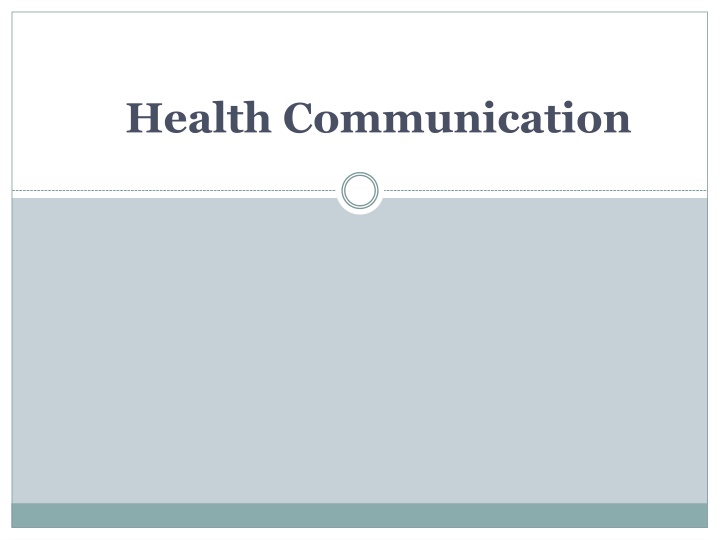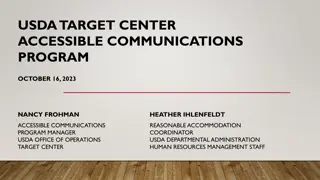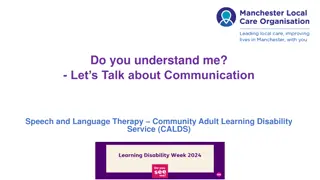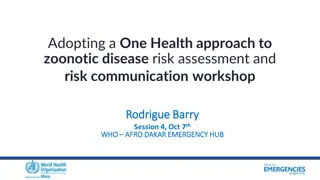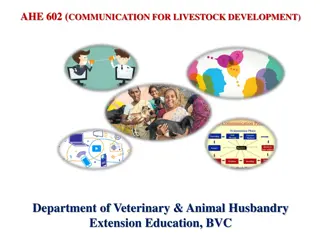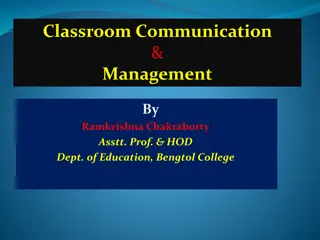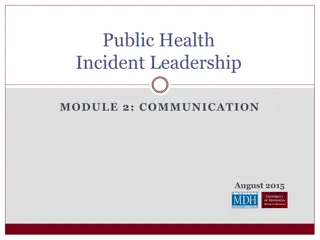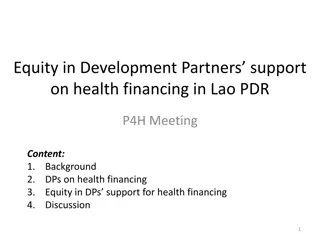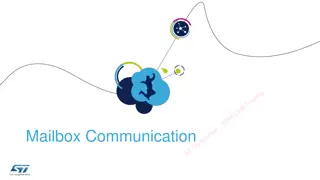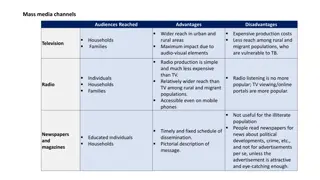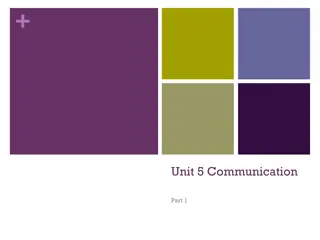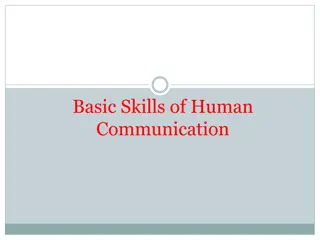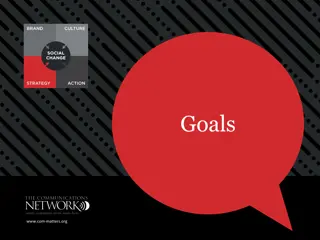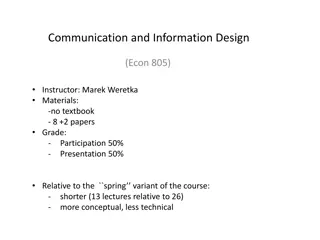Health Communication Overview - Strategies and Importance
Health communication is a vital aspect of informing and influencing individual and community decisions to enhance health outcomes. It involves studying and utilizing communication strategies to shape knowledge, attitudes, and practices related to health and healthcare. Effective health communication can positively impact patient-provider relationships, medical outcomes, and overall healthcare system utilization. However, poor communication can lead to negative consequences such as low patient compliance and weak patient participation. Recognizing the significance of health communication and its impact is crucial for all healthcare professionals to ensure successful communication practices.
Download Presentation

Please find below an Image/Link to download the presentation.
The content on the website is provided AS IS for your information and personal use only. It may not be sold, licensed, or shared on other websites without obtaining consent from the author.If you encounter any issues during the download, it is possible that the publisher has removed the file from their server.
You are allowed to download the files provided on this website for personal or commercial use, subject to the condition that they are used lawfully. All files are the property of their respective owners.
The content on the website is provided AS IS for your information and personal use only. It may not be sold, licensed, or shared on other websites without obtaining consent from the author.
E N D
Presentation Transcript
Objectives: By the end of this lecture, you will be able to: Define health communication Recognize the importance of health communication Identify the most important concepts related to health communication Identify the most important health communication principles Start developing cultural competency for successful health communication
Health Communication Is the study and use of communication strategies to inform and influence individual and community decisions that enhance health. Healthy People 2010
Function of health communication Health communication includes the study and use of communication strategies to inform and influence individual and community knowledge, attitudes and practices (KAP) with regard to health and healthcare.
Effective Health Communication Not Just for Physicians Understanding and delivering effective health communication is the charge of all health care professionals from all parts of your organization Physicians Dentists Nurses Health educators Social Workers Front-office staff Billing staff Pharmacists
Importance of Health Communication Effective health communication can lead to positive health outcomes Better use of the health care system Better medical outcomes Improved patient-provider relationships. Poor health communication can lead to negative outcomes Low patients compliance Low patient participation Weak patient-provider relationships
FACTS Up to 80% of patients forget what their doctor said as soon as they leave the doctor s office Nearly 50% of what patients remember is recalled incorrectly
Think. How many of the individuals you serve do you think remember what you say? Are you sure? How do you know?
Health communication overview Health communication is a critical public health competency for all diseases and has become especially important in communicable diseases. The surfacing of new infectious organisms, microbial resistance to therapeutic drugs, new environmental related phenomena and the new emerging diseases represent public health threats that can spread quickly and unexpectedly.
Purpose of Health Communication Health Communication serves the following purposes : Initiating actions 1. 2. Making known needs and requirements. 3. Exchanging information, ideas, and beliefs 4. Creating understanding 5. Establishing relations. 6. Train and assist to adopt desired change and maintain it.
Some important concepts related to Health Communication Health literacy Health literacy can be defined as the capacity that an individual has to access and effectively use health-related information. Health education Health education aims to influence a person s knowledge, attitudes and behaviours connected to health in a positive way. Social marketing Is the planning and implementation of programs designed to bring about social change using concepts from commercial marketing for the purpose of societal benefit rather than commercial profit.
Important concepts related to Health Communication (cont ) Health advocacy Advocacy is one strategy to raise awareness and promote health and access to quality health care at the individual and community levels. Outbreak communication An effective outbreak communication can help to bring an outbreak under control as quickly as possible, with as little social disruption as possible.
Health Literacy Health literacy involves a range of social and individual factors which are influenced by educational systems, health systems, culture, and language.
Why Learn About Health Literacy? Findings from Inadequate Functional Health Literacy Among Patients at Two Public Hospitals 2009
Identifying Limited Health Literacy Every day there are patients who have trouble reading and understanding health information Even people with adequate health literacy skills may have trouble understanding and applying health care information, especially when it is explained in unfamiliar technical terms
Tools and Techniques for Identifying Limited Literacy RED FLAGS Patient registration forms incomplete or inaccurately completed Appointments frequently missed Not following medication directions or procedures Inability to describe how to take medications Lack of follow-through with referrals to consultants Help sought only when illness is advanced May not be able to articulate symptoms or time course of illness
Tools and Techniques for Improving Communication Slow Down! Such patient-centered visits take no longer than traditional visits, in which the agenda is set by the health care provider. Behaviors such as sitting rather than standing, listening rather than speaking, and speaking slowly, can help to reinforce the impression that you are focused on the patient.
Tools and Techniques for Improving Communication Use Plain, Nonmedical Language Most people have trouble understanding words used in health care. In others, a word may be familiar, but the person may not understand it in a health care context. Words that providers use in their day-to-day conversations with colleagues may be unfamiliar to the majority of persons who are not medically trained.
Tools and Techniques for Improving Communication PLAIN LANGUAGE!!! Evidence indicates that all patients prefer easy-to- read materials to more complex or comprehensive materials. Focus on instructions for key behaviors that the patient must put into action Create materials for readability at the 6th- to 8th- grade level Larger text (10- to 12-point) and fill it with blank space Bullets and clear illustrations
Education and Training It is a proven fact that education and training to those who feel sick is absolutely a vital tool. When people are sick they are afraid of not getting better. Here education, training and communication work like a thrilling instrument.
Health Communication Principles Accuracy: The content is valid and without errors of fact, interpretation, or judgment. Availability: The content (whether targeted message or other information) is delivered or placed where the audience can access it. Balance: the content presents the benefits and risks of potential actions
Health communication principles Consistency: The content remains internally consistent over time and also consistent with information from other sources. Cultural competence: The design, implementation, and evaluation process that accounts for special issues for select population groups and also educational levels and disability. Evidence base: Relevant scientific evidence that has undergone comprehensive review and rigorous analysis to formulate practice guidelines, performance measure, review criteria, and technology assessments.
Health communication principles Reach: The content gets to or is available to the largest possible number of people in the target population. Interest: Involvement and active participation without aim to gain personal publicity. Ability to understand: The reading or language level and format (including multimedia) are appropriate for the specific audience.
Cultural Competency in Health communication Cultural Bias is Everywhere Research shows that individuals who are culturally different from their providers are less likely to: Establish a connection and trust with providers Receive sufficient information Be encouraged to participate in medical decision- making
Culture and Health Culture is also a central issue in people s health care. A person's culture can affect: How health care information is received How rights and protections are exercised What is considered to be a health problem How symptoms and concerns about the problem are expressed Who provides treatment for the problem What types of treatment should be given
Cultural Factors Influencing Patient- Provider Communication Nonverbal Communication Varies greatly among people, often leading to cross- cultural misunderstanding. Facial Expressions Head Movements Hand and Arm Gestures Personal Space Touching Eye Contact Physical Postures
Cultural Factors Influencing Patient- Provider Communication Many cultures feel providers have a higher status and will therefore expect the provider to take charge. The patient may not wish to participate in making decisions about his/her treatment, and may appear passive in the process
Developing Cultural Competency Fact-Centered Approach What to do: Gain cultural information about specific ethnic groups How to do it: Learn culture-specific information, such as an ethnic group s historical context, cultural concepts of illness and disease, health-seeking behaviors, health- oriented data and disease patterns, and so on.
Developing Cultural Competency Attitude/Skill-Centered Approach What to do: Enhance communication skills and focus on the cultural values and beliefs of individuals (including yourself) How to do it: Recognize and acknowledge your own biases; understand yourself and others in terms of culture; understand how race, ethnicity, gender, spirituality, and other issues play a role in delivery and in perceptions of health care; and acquire and apply culturally competent communication skills
An effective communication strategy should be based on: 1. Interpersonal skills: interpersonal skills are those skills that enable us to interact with another person, allowing us to communicate successfully with them, 2. Positive relationships with work colleagues and other professionals 3. You should be assertive and calm not aggressive during communication with patients and his family members.
An effective communication strategy should based on: 5.Language barriers are a common challenge. Overcome this dilemma with best possible way. Speak clearly and slowly during your communication with patients and his family members. 7. Define the basics purpose of your meeting with the patients. Be specific. NO long stories required. Give example if required. 8. Be careful of jargon. (Technical language with interacting with patients)
